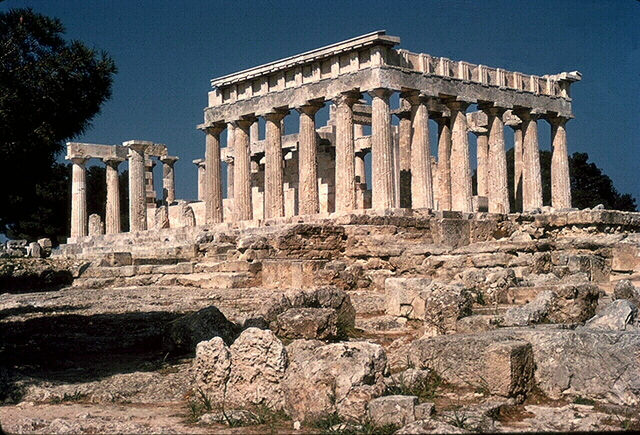

 was built in 490 - 510 BC and is of the late
standard Doric form
It consists of a megaron-style cella surrounded by a peristyle
with 13 columns by 6 columns. The interior columns, which had to reach
a greater height than the exterior colonnade, were constructed in two tiers.
was built in 490 - 510 BC and is of the late
standard Doric form
It consists of a megaron-style cella surrounded by a peristyle
with 13 columns by 6 columns. The interior columns, which had to reach
a greater height than the exterior colonnade, were constructed in two tiers.
 The material for the structure was local limestone, faced with
cream-painted marble stucco.
The floral acroteria and pedimental sculptures depicting fighting scenes
were carved from marble, introduced by sculptors
during the late 6th century BC. and were richly painted in bright colours
The sculpture from the pediment was
restored and installed in the Glyptothek in Munich by Bertel
Thorvaldsen. The temple exhibits numerous refinements of
proportion. All the columns tilt inward and those on the corners
are slightly thickened. The columns also have entasis, i.e. the
profile has slight curvature.
The material for the structure was local limestone, faced with
cream-painted marble stucco.
The floral acroteria and pedimental sculptures depicting fighting scenes
were carved from marble, introduced by sculptors
during the late 6th century BC. and were richly painted in bright colours
The sculpture from the pediment was
restored and installed in the Glyptothek in Munich by Bertel
Thorvaldsen. The temple exhibits numerous refinements of
proportion. All the columns tilt inward and those on the corners
are slightly thickened. The columns also have entasis, i.e. the
profile has slight curvature.
The temple was excavated by Furtwängler and others who supplied detailed perspective reconstructions in their report.
See a 3D VRML representation. of my model.